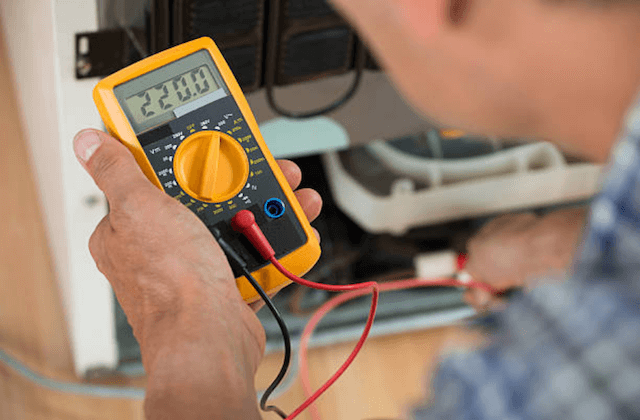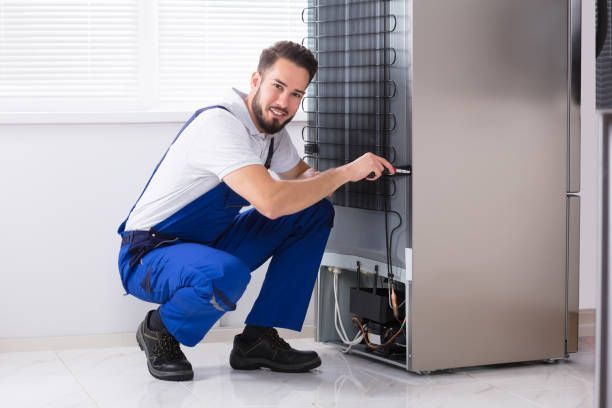The Hidden Dangers of Delaying Small Repairs—Call Dependable Refrigeration & Appliance Repair Service Today
The Hidden Dangers of Delaying Small Repairs—Call Dependable Refrigeration & Appliance Repair Service Today
Blog Article
The Ultimate Overview to DIY Device Repair Work Strategies
When home appliances break down, it's very easy to feel overloaded. Dependable Refrigeration & Appliance Repair Service Sub-Zero Appliance Repair. But with the ideal knowledge and devices, you can tackle typical concerns yourself. From refrigerators to dish washers, understanding exactly how to troubleshoot and fix these tools can conserve you money and time. Are you ready to find necessary methods that will encourage you to handle repair work with confidence? Allow's discover the vital locations where DIY skills can make a considerable distinction.
Recognizing Usual Home Appliance Issues
When you count on your home devices, it can be frustrating when they all of a sudden stop functioning or act up. Comprehending common device issues can help you repair problems efficiently.
If your oven isn't home heating, defective components or thermostat problems could be at fault. Dish washers usually experience issues with water drainage, so ensure the filter is tidy and the drainpipe pipe isn't kinked.
Also, pay attention for unusual noises; they often show mechanical issues. By identifying these indications, you can conserve time and potentially stay clear of costly repair services. A little knowledge goes a long means in preserving your devices, so stay notified to maintain everything running smoothly.
Crucial Tools for DIY Services
Before diving into do it yourself home appliance repairs, it's crucial to collect the right tools to ensure the procedure goes efficiently. Start with a good set of screwdrivers, consisting of both flathead and Phillips, as they're essential for opening up most home appliances. You'll additionally desire a set of pliers for gripping and twisting cables or tiny components.
Don't fail to remember a multimeter; it helps you test electric parts and detect issues efficiently. A socket set is useful for loosening up or tightening up screws, while an energy blade can be useful for opening or reducing wires product packaging.
Ultimately, take into consideration having a flashlight accessible to brighten dark rooms inside your appliances. With these crucial tools, you'll be well-equipped to take on numerous repair work, saving both time and money. Gather your equipment and obtain all set to roll up your sleeves!
Safety First: Precautions to Take
Before you start any kind of device repair service, it's essential to prioritize safety. Make sure you put on individual protective equipment, disconnect the source of power, and maintain your job area organized. These easy safety measures can help prevent accidents and assure a smoother repair service process.

Personal Protective Devices
Security equipment is a crucial part of any type of do it yourself home appliance repair service task. You need to always wear safety goggles to safeguard your eyes from dust and debris. A durable pair of gloves will shield your hands from sharp edges and dangerous materials. Consider using a mask if you're handling chemicals or dust, ensuring you breathe securely while functioning. Steel-toed boots are likewise a wise option, particularly when lifting heavy devices. Do not fail to remember to use lengthy sleeves and pants to shield your skin from prospective injuries. By prioritizing personal protective equipment, you'll considerably minimize the danger of accidents and injuries. Bear in mind, being prepared with the ideal equipment keeps you secure and concentrated on completing your repair successfully.
Source Of Power Disconnection
To assure a risk-free DIY home appliance repair, separating the power source is essential. Prior to you start any kind of work, you must unplug the device or turn off the circuit breaker. This simple step protects against electric shocks and warranties that you can focus on the repair service without fretting about unintentional activation. Constantly double-check that the home appliance is off by examining it with a voltage tester. If you're handling bigger appliances, like a washing machine or clothes dryer, see to it to protect the power cable and avoid any type of call with water. Remember, security initially! When you're certain that the power is separated, you can confidently continue with your repairs, understanding you have actually taken the essential precautions to safeguard on your own.
Workspace Organization
A well-organized workplace can make all the difference in your DIY appliance repair project. Beginning by removing your work space of clutter to stop crashes and disturbances. Set out all your tools and materials, organizing similar products together for easy access. Use a toolbox or coordinator to maintain little parts like screws and washers consisted of and identified. Make sure you've obtained adequate lights; it'll help you see details clearly and decrease the danger of blunders. Don't neglect to keep safety and security equipment like gloves and safety glasses accessible. Have a garbage bag useful to dispose of waste promptly. A clean area not just improves performance yet also maintains you safe while you function on your home appliance repair.
Step-by-Step Guide for Refrigerator Services
When your fridge starts acting up, it can be irritating, yet tackling the problem yourself can conserve you time and cash. Examine for typical concerns like temperature level variations or uncommon sounds. For a noisy fridge, check the follower and verify it's not blocked.
If there's water merging within, examine the door seals for damage or dust, and clean them if essential. For ice accumulation, clear the defrost drainpipe. As soon as you have actually resolved the concern, connect this post the refrigerator back in and check it for a few hours. If the issue continues, you may require to change a malfunctioning component, like the compressor or follower electric motor. Bear in mind, do not be reluctant to seek advice from the handbook or seek specialist help if required.
Dealing With Washing Equipment Concerns
Just like refrigerators, washing makers can offer their own set of difficulties, however several concerns can be settled with a little bit of troubleshooting. If your equipment will not begin, inspect the power cable and verify it's plugged in.
Tightening up these can frequently resolve the problem. Normal maintenance, like cleaning the filter, can protect against several problems from arising.
Troubleshooting Cooktops and stoves
Exactly how can you troubleshoot usual problems with your oven or range? Start by inspecting the power supply. Ensure it's connected in and the circuit breaker is not tripped. If it's a gas cooktop, confirm the gas valve is open. Next off, test the heaters: if they don't stir up, clean up the igniter and check for blockages in the burner ports.
If your stove isn't heating, check the temperature setups and confirm the door seals securely. A defective burner might likewise be the culprit; you could require to replace it if it's damaged.
For unequal cooking, rotate your pans and take into consideration using an oven thermostat to validate accurate temperatures. If you hear unusual noises or scent gas, transform off the device instantly and seek advice from a specialist. By complying with these actions, you can recognize and fix many common oven and range problems successfully.
Repairing Dishwashing Machines Facilitated
When your dish washer begins breaking down, it can be irritating, yet addressing common issues isn't as difficult as it seems. You'll learn step-by-step troubleshooting methods that will help you pinpoint the problem, along with the vital tools you'll need to tackle repair work yourself. Let's make repairing your dish washer a wind!
Common Dishwasher Issues
While dishwashing machines are designed to make your life simpler, they can often run right into usual issues that leave you feeling discouraged. If your dishwasher's door won't latch, it might be a straightforward issue with the latch mechanism or door seal. Attending to these problems early can conserve you time and hassle down the road.

Detailed Troubleshooting
Before diving into repairs, it's crucial to recognize the certain concern your dishwashing machine is encountering. Begin by checking if it's not cleaning up properly. Evaluate the spray arms for clogs and assurance they rotate freely. Examine door seals and hose pipes for any type of damages if it's dripping. For strange noises, pay attention very closely throughout cycles; foreign objects may be embeded the filter or impeller. Examine the power supply and door lock if your dishwasher won't start. Don't fail to remember to consult your customer handbook for fixing pointers details to your model. By systematically attending to each possible issue, you can pinpoint the issue and take the essential steps to fix it, making your dishwashing machine feature fresh once again.
Necessary Repair Service Devices
Having the right devices at hand can make all the difference when repairing your dishwasher. Start with a screwdriver set, as you'll often require both Phillips and flathead choices. A multimeter's vital for diagnosing electric concerns, while pliers can assist you grip and manipulate various elements. Don't neglect a container or towels for any type of water splashes during repairs.
You may additionally want a degree to assure your dishwashing machine's effectively aligned. With these necessary devices, you'll be well-equipped to deal with any kind of dishwasher fixing challenge that comes your method.
Often Asked Inquiries
If an Appliance Is Worth Fixing?, how Do I Identify.
To identify if a device's worth fixing, consider its age, repair work expenses, and existing value. You might want to spend in a brand-new model rather - Dependable Refrigeration & Appliance Repair Service SubZero Repair. if repair work surpass half the replacement cost.
Can I Locate Substitute Components Locally for My Appliance?
Yes, you can often locate replacement parts locally click here to find out more for your device. Examine hardware stores, device fixing stores, or regional classifieds. Don't neglect to bring the model number to guarantee you obtain the appropriate part!
What Usual Mistakes Should I Prevent When Repairing Devices?
When fixing home appliances, avoid hurrying with diagnostics, ignoring safety and security precautions, or making use of inaccurate tools. Do not skip reviewing handbooks or watching tutorials; they give vital guidance. Be person and complete to guarantee effective repair work and protect web link against additional damages.
Exactly how Long Does a Normal Do It Yourself Home Appliance Repair Take?
A normal DIY device repair usually takes one to 3 hours, depending upon the complexity. You'll desire to gather your materials and tools initially, and follow directions carefully to prevent unneeded hold-ups.
Are There Any Type Of Service Warranties for DIY Home Appliance Services?
When you tackle DIY device repairs, guarantees commonly don't cover your work. Some makers could recognize service warranties for parts you replace. Always check your device's service warranty terms prior to beginning any repair work to prevent problems.
Before diving right into Do it yourself home appliance fixings, it's important to gather the right tools to guarantee the process goes smoothly.Before you start any appliance repair work, it's vital to focus on safety and security.To assure a secure Do it yourself device fixing, separating the power resource is crucial.An efficient job location can make all the distinction in your DIY home appliance repair work project. Always check your device's service warranty terms prior to beginning any type of repairs to stay clear of problems.
Report this page